At a time when quite a few mid-century Modernist structures are threatened with demolition, a new retrospective exhibition at the National Building Museum in Washington, D.C., aims to remind people of the contribution that Modernist architects made through their bold experimentation with forms and materials.
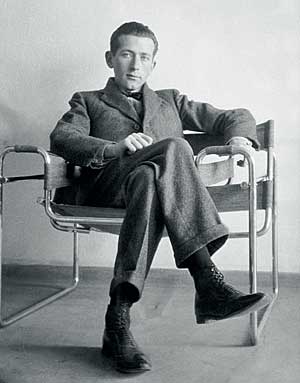
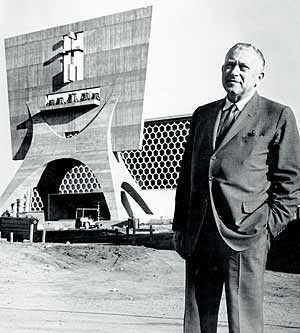
Marcel Breuer in the Wassily chair, circa 1926 (top). Breuer standing in front of the Saint John’s Abbey and university complex, Collegeville, Minnesota, during its construction circa 1961 (above).
It’s especially fitting that the show focuses on Marcel Breuer, who was widely eulogized as the last Modernist upon his death in 1981. He is again in the headlines now as his buildings meet with uncertain fates. In Cleveland, for instance, the Ameritrust Building awaits demolition. It was built in 1971 as an addition to the historic Cleveland Trust Building; the rain-stained concrete tower perches like an unloved stepchild next to the better-preserved Romanesque domed structure. It will be replaced by a new municipal office building. In Grosse Point, Michigan, his 1953-vintage Public Library barely escaped a similar fate.
Marcel Breuer: Design and Architecture, which opened last week, traces Breuer’s creative evolution from a furniture and interior designer to an architect. In doing so, it treats all aspects of his oeuvre with equal weight, be it a coffee table or the Whitney Museum of American Art building in New York City. “It calls to attention Breuer’s artistry,” says Susan Piedmont-Palladino, the Building Museum’s coordinating curator overseeing the show. “This exhibit gives him exposure: He was an architect hiding in plain sight.”
At Germany’s famed Bauhaus, where the Hungarian designer learned under Walter Gropius, Breuer peaked early as a prodigy with the invention of the tubular steel Wassily chair. But not until after he emigrated to the United States in 1937 did he start his architecture practice. The exhibition presents 12 building models custom made for the show, three of which—all ecclesiastical structures—are cross sections that allow glimpses into the geometric forms that Breuer so often explored. Also on display also are his working sketches, dotted with handwritten notes and corrections, illustrating the meticulousness that underlay the apparent playfulness of his designs.
The exhibition is organized under themes, such as “texture” and “cantilever,” that encapsulate Breuer’s approach. For instance, he treated concrete as more than a structural material and designed with the goal of accentuating the effect of light and shadow cast on an unfinished concrete surface. And he considered the cantilever, such as the Whitney museum’s iconic facade, to be more than just decorative: it was a form that expressed the Modernist idea of freedom from load-bearing walls.
Marcel Breuer: Design and Architecture was developed in 2001 by the Vitra Design Museum in Germany, which houses one of the world’s most extensive and comprehensive collection of the architect’s furniture designs. The exhibition will remain in Washington, D.C., until February 17, 2008, to be followed in May by a show celebrating another Modernist master, Eero Saarinen.

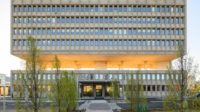
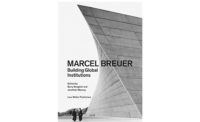
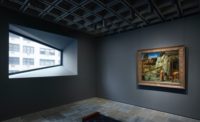


Post a comment to this article
Report Abusive Comment